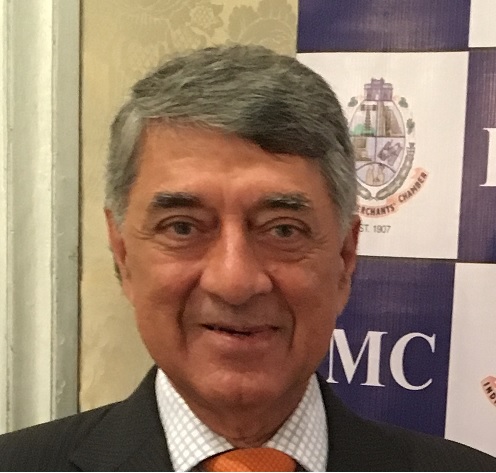Tax World reacts to passage of landmark GST reform
Read below what some of the biggest Indirect Tax Experts have to say on this Red Letter Day for the Indian Economy.
-

-

-

-

-

-

-

-

-

-

-

-
- Lok Sabha to pass amended Constitutional Amendment Bill
- Constitutional Amendment Bill to be ratified by at least 50% of State legislatures
- President to give assent for enactment of Constitutional Amendment Bill
- GST Council to be formed within 60 days Presidential assent. GST Council to recommend on key aspects such as GST rates, taxable base, exemptions, etc.
- Centre and States to place GST Acts and Rules in the public domain for comments and suggestions and then to enact the Acts and Rules
- Goods and Service Tax Network (‘GSTN’) to be rolled out and adopted by all stakeholders i.e. Centre, States, Businesses
-

- Approval of Lok Sabha on the amendments proposed by Rajya Sabha in GST Bill;
- Ratification of the said GST Bill by at least 50% of the States;
- Constitution of GST Council and important decisions to be taken on taxes to be subsumed, exemptions, threshold limits and various other principles governing levy;
- Finalization of Model GST laws after consultations with all stakeholders;
- Putting in place the necessary integrated pan-India IT infrastructure along with a robust training to prepare all the stake holders for the transition to GST;
- Passage of Central GST and Inter-State GST laws by Parliament and State GST laws by each of the state legislatures. This would be an important step as the government would want to ensure that GST becomes effective throughout India in one go;
-

-

“I congratulate the Government on this significant milestone of passing the long awaited Constitutional Amendment Bill on GST. It is indeed a landmark indirect tax reform of independent India. I reckon it as a matter of great excitement and pride that we belong to this era when this change has been ushered in. The Empowered Committee of State Finance Ministers, under the stewardship of successive chairpersons over time, needs to be complimented and thanked for bringing about the consensus amongst States, which in the context of our current political milieu, is a stupendous achievement. The relentless and dedicated efforts of officers of the Central and State Governments, who were given the demanding task of advising and assisting the Empowered Committee, drafting the business rules and the model GST Law, is also commendable as they channelized their vast working knowledge on indirect taxes. The indirect tax burden on goods, which is borne by the poor too, is expected to be lower and that would be the most satisfying outcome of the GST regime. The services industry, which has been subjected to one national tax – service tax, has to contend with multiple administration and multiple stages of levies.
One may ponder as to why the Constitution of India did not originally vest taxation powers on States with regard to services. Only few location specific services such as provision of luxury, entertainment etc. were included in the taxation powers of States. Even services in the nature of leases, supply of food etc. were later deemed as goods to allocate the taxation powers to the States. It was possibly for the reason that services are intangible in nature and the apparent receivers of services may be different from the actual users / beneficiaries of such services and therefore contentious issues would arise as to which State has the taxation powers. It is a bold step as that difficulty of the past is sought to be overcome in the Constitution Amendment Bill, particularly in a digital world. The focus should now shift quickly to effective implementation of GST Law. The Government, the trade & Industry must collectively work together in coming up with a structure and the laws which would sub-serve the objects mandated in the Constitution Amendment Bill.”
“Great day for one India and one Indirect Tax system. The matured debates today in Rajya Sabha bring solace to the Indian citizen whose trust in our Parliament stands taller.
On the way forward we need greater maturity in getting the rates band right and ushering a code which addresses all sections of the society, trade and Industry with great care and understanding.
We need a code that trusts the Trade and Industry and one which will have minimum supervision and maximum balance between revenue needs and demands of stakeholders.
A red letter day for Our PM and his Team. Three Cheers”
“The passage of the Constitution Amendment Bill by Rajya Sabha is historic and paves the way for early introduction of GST. The political maturity demonstrated by both the Government and the opposition in forging a consensus for this landmark event is commendable. This indeed will be the most significant tax reform since independence setting the stage for a regime that can ignite the manufacturing landscape to enable Make in India in One India.”
“The passage of GST Constitution Amendment Bill is one of the most significant events in the economic history of India. The passage of the Bill will signify the culmination of a process which has been pending for over 9 years, since the GST was first conceptualised for India. While a significant milestone will be crossed, the work to be done to effectuate GST will be complex, and pose its own challenges. The real challenges are as to the formulation of the rate and a GST law that is universally accepted by the Centre and all States. There is much reason to celebrate – there is also a difficult path still to be traversed.
The issue of the dispute resolution mechanism will also raise substantive Constitutional issues, in terms of how such a mechanism can be made compatible with Article 131 of the Constitution, which secures the primacy of the Hon’ble Supreme Court to deal with this nature of issues. There may still be need for some more Constitutional amendments to work out a dispute resolution mechanism for GST.”
“Finally the largest tax reform in Indian history has sailed through the toughest hurricane. The much awaited Goods and Services Tax (‘GST’) is finally ready to get constitutionalized as the Upper House of the Parliament has passed the Constitution (122nd Amendment) Bill, 2014 (‘the Bill’). The unanimous consent over the amendments to the Bill reflected during voting by the Rajya Sabha members reaffirms the agreement amongst all political parties of the country over GST being the single biggest economic reform that the nation awaits.
The key amendments moved to the Bill include dropping of 1 per cent additional tax which was earlier proposed to be applied on the inter-state supplies. The additional tax would have distorted the GST design and led to cascading of taxes, thereby negating the potential benefits of the GST structure. Elimination of this tax would enable businesses to structure their operations based on commercial imperatives rather than being guided by the tax environment. The proposed amendments suggest that the Parliament would now be necessarily required to legislate on providing compensation to the States for any loss of revenues, thereby, giving the compensation mechanism a statutory backing. It has also been made obligatory for the GST council to develop a mechanism for addressing disputes between various Governments arising out of the recommendations of the GST council. The proposed amendments are likely to make the GST design and policy mechanism robust and efficient.
While the unanimous voting to the Bill surely signals political unity over intention to implement GST, the concerns expressed almost by all speakers during debate hours over the challenges ahead including achieving consensuses over GST rate cannot be undermined. As next steps, 50 percent of the States shall have to ratify the Bill followed by the assent of the President. The GST council can be constituted only after the Presidential assent. Meanwhile, the Empowered Committee would need to develop consensus on complex matters such as tax rates, exemptions, threshold limits, dual administration etc. Once such consensus is arrived at and blessed by the GST council, various GST legislations such as the Central GST law, Integrated GST law and 29 State GST laws including allied rules and notifications would need to be passed by the relevant legislative bodies. During this process, there would also be a need for a substantial engagement with the industry bodies. Meeting the timeline of implementing GST by April 1, 2017 would require these processes to run in parallel and in a time bound manner. That said, since the ball has been set rolling, GST will surely see the light of the day, sooner or later.
All eyes would now be set on progress by the Government for introduction and implementation of GST. Considering much of the work still left to be done in this direction, both Government as well as the industry will now need to pull up their socks and start gearing up towards the implementation of GST. It’s time to set things in motion and start preparing for GST as the time left is really short."
“It is a historical moment as most of the parties have agreed to pave way for the biggest amendment of our times. In a federal structure like India, it is extremely difficult to bring a consensus between two houses and the States on such a major reform. This Bill may have taken a decade to pass, but finally we are ready to see the future.
In the course of today’s debate in Rajya Sabha the most contentious issue appeared to be the rate of GST including capping the rate of GST under the Constitution itself. However, Congress appears to have softened its stance on the issue.
Another point on which most members seemed to be in consensus was that the GST bill should not be introduced as a ‘money bill’ - when a money bill is introduced, Rajya Sabha can only provide recommendations, which may or may not be accepted by Lok Sabha.
In a welcome move the additional tax of 1% on inter-state supply of goods/services has been dropped as it was not aligned with the concept of GST.
The stark difference between the amendment Bill brought in 2011 and 2014 was apropos creation of a dispute settlement authority to adjudicate disputes between the central and state governments. However, the same was dropped, as it would have had the effect of overriding the supremacy of Parliament and the state legislatures. It would be interesting to see as to how the GST Council will decide upon the modalities to resolve disputes arising out of its recommendations, as proposed in the amendments introduced yesterday.”
alongwith Jigar S. Doshi (Partner)
“After spending more than a decade in parliamentary debates, the 122nd Constitutional Amendment Bill (Goods and Services Tax Bill – GST Bill) finally saw the light of the day. The passage of GST Bill through the Rajya Sabha with majority of the parties in its support, showcases an active effort of the parliamentarians to debate, deliberate and legislate for the common man and his needs and rise above conflicts when it is needed so. The implementation of GST in India will ensure a semantic restructuring of India’s multi-layered indirect tax structure. The proposed GST indirect tax structure will certainly augur well with the government’s efforts to increase ‘Ease of Doing Business in India’ and in turn attract further growth & Foreign Direct Investment (FDI) into India.
If Global experience of GST were to be leveraged, then India should certainly expect 1-2% GDP growth and an increased Investor confidence in Brand India post implementation of GST. Now that GST is through its most critical path (its passage through Rajya Sabha), India Inc. shall start considering April 2017 implementation date as a realistic possibility, and prepare for the transition accordingly. As a part of process, now the bill has to pass through Lok Sabha for amendments therein and require ratification by more than 50% of state. This is just the beginning of GST marathon and race is now against the time to see its actual implementation at the earliest”
“The GST Constitution Amendment Bill finally sees the light of day after many years of speculation and heartburn. While there are still many steps to introduce GST in India, we remain optimistic that the toughest hurdle is now crossed over. The question around GST is no longer "if" it's coming but now "when" is it coming.”
“The Constitutional (One Twenty Second Amendment) Bill, 2014 enabling the levy of Goods and Service Tax being passed is a big moment in the history of our Country. The Bill in its new form would not include the levy of 1% Additional tax on inter-state supply of goods, would now mandate the centre to compensate the state for deficits up to five years and would enable the States to get its revenue without waiting for the appropriation from the Consolidated Fund of India.
It is heartening to know that the Bill has been passed in spite of the difference amongst the political parties on various issues including those on having a cap of 18% rate in the bill, powers of Centre in the GST Council, etc.
It was undoubtedly a master stroke by the Honourable Finance Minister as he got through all his points and even remaining non-committal on the demand of opposition party to treat the draft law bill as a Finance bill as opposed to Money bill. He answered every issue raised by the members of the Rajya Sabha in a deft manner.
On a negative note, while answering the issue in relation to Entry Tax and Octroi (levied by Municipalities) for the States like Maharashtra and Karnataka, he did mention that the States would have power to allow Municipalities to levy and collect such taxes referring to Article 243X of the Constitution which would mean that industries may have to grapple with additional taxes beyond GST.
The passing of the GST bill means that the trade and industry would now have to wake up and start gearing up for the country’s largest reform, the Goods and Service Tax.”
"GST has been one of the biggest reform which after innumerable obstacles saw the passage in Rajya Sabha wherein the government had to give to the opposition demands The next challenge is its implementation which is likely to face severe challenges but with the determination of the government it is expected to pave way for the indirect taxes system seamlessly and it will be a win-win situation for government/ industry/ consumers. Efficiencies as contemplated in GST is estimated to lead GDP growth upward by 1-2 % and it would constitute India into a single largest common market. The present distortionary indirect tax system effectively is addressed by shifting the tax burden from production and trade to final consumption. The introduction of the GST will bring a macroeconomic dividend by reducing what have been called the “negative grey area dynamic effects” of cascading taxation. The flawless GST subsumes all indirect taxes on goods and services, which is the most appropriate method of taxing consumption. Under this structure, all different stages of production and distribution will be a pass-through and the tax essentially ‘sticks’ on final consumption within the taxing jurisdiction.
The ‘flawless’ GST envisages full and immediate credit for GST on capital goods and this will enhances the productivity and would encourage savings and bring about new investment in the economy.
With the passage of GST, the price control mechanism needs to ensure that consumer gets full benefits from reduction in tax rates due to seamless tax credit mechanism. May be a Commission to protect the interest of the consumer would be ideal towards implantation of the GST.
While in the long-run GST would have a positive impact on inflation and government finances, in the near-term, inflation cannot be ruled out and government finances may be strained due to compensation to states for the initial period. Compliances burden is likely to be high for small traders and all interstate stock transfers will become taxable thereby increasing the requirement of working capital and high tax rate may lead to inflationary scenario in the country which might continue for initial years and the current tax breaks in specified areas are likely to get setbacks as such exemptions may not continue.
In terms of the affirmation and righteous intent on Goods and Service Tax to be implemented in the country, possibility of its implementation from April 01, 2017 GST would be arduous, if not impossible, to meet."
"A truly historic moment! Absolute delight to witness a very matured and informed debate in the Parliament today on 122ndConstitution Amendment Bill, 2014; two legal luminaries reading out Articles of the Constitution and Clauses of the Bill while putting their view points across!
As the euphoria of passage of the Bill settles down, we will have to get down to the tougher task of facilitating finalization of the Draft GST Bills – the Central GST Bill, the Integrated GST Bill and the State GST Bill. The Model Draft GST Bill and the reports on processes are in public domain for over a month. Each one will have to be studied at depth, provisions applied to practical situations and difficulties and challenges in implementation will need to be identified and communicated.
The Draft Model GST Law has been prepared after detailed deliberations in the Empowered Committee of Finance Ministers over several months. This Draft is an excellent working document consolidating provisions of Central Excise Duty, Service Tax and State VAT. The draft seeks to address some of the current disputes and takes into consideration several challenges indicated by different sections from time to time and draws upon the provisions contained in GST/VAT laws in other jurisdictions.
It is now time for all of us to study, analyse, apply the draft provisions to practical situations and provide suggestions to obviate difficulties, be it in relation to design issues or implementation ones e.g. activities deemed to be supplies, stock transfers within and outside the State and several others."
"Yesterday night, history was created as the Constitutional Amendment Bill was passed in the Rajya Sabha unanimously paving the way for the biggest tax reform in India since independence, in the form of GST. This is significant step towards the dream of one country - one tax and India becoming one market from an indirect tax perspective.
Scrapping of the most dreaded 1% non creditable additional tax which was a dichotomy in the proposed GST framework, was a big relief for India Inc.
While, the opposition parties insisted on an upper cap in the GST rate at 18%, the Finance Minister assured that the rate would be as reasonable as possible, certainly lower than the existing indirect tax rates.
The next steps for GST roll out now are:
GST, over a period, could free India from the complex indirect tax laws and usher in a new era of a rational tax system in line with the international regime and which is conducive to growth and prosperity. GST is expected to remove the distortions and inefficiencies in the current indirect tax system and pave the way for a higher GDP."
“The passage of the Constitutional (122nd Amendment) Bill, 2014 (“GST Bill”) is a landmark step for Indian economy and showcase India’s commitment to economic reforms and ensuring ease of doing business. The said passage has set the ball rolling for actual implementation process, which may still take another year (hopefully) or may be two depending on the political will of the Central Government. There are various hurdles which the Centre and the State Governments would have to cross before GST can become a reality, which includes -
Clearly, implementation of GST is very high on the priority for the government, and the industry is hopeful that all political parties would continue the momentum on GST to ensure that all these hurdles are crossed in timely manner.”
"It’s a major step towards transformation and will comfort Global Financial institutions who take a long term position like Pension Funds and Sovereign Funds.
The GST rate should be maximum 18%, for two reasons; firstly, the current tax impact in the industry is between 25 to 30%, this would mean a 10% reduction making exports competitive, Secondly this will encourage larger tax collection.
Almost 50% of our GDP is with the unorganized sector and approximately 25% of the GDP is grey money. This would come under GST thus GDP would grow.
As per Logistics the hurdles at check points would be knocked off, as a result the money collected unofficially would substantially reduce, adding to the GDP. The Warehouses will also disappear, thus, reducing manufacturing cost."
"The much awaited Constitutional Amendment Bill has been finally passed by Rajya Sabha. The remaining process of ratification by 50% of the State legislatures, is expected to be completed smoothly.
All attention would now move to discussions between the Central Government and State Governments on critical issues such as rates, dual control, list of exempt products/services and place of supply rules.
Industry would also need to now actively engage with the Government on various aspects of the Model GST law.
The eco-system of introducing the new tax system would now start evolving in terms of GST legislation, GSTN system, tax administrative framework, ERP vendors gearing to release the GST updates and industry preparing for transition. There is lot of work to be done!
Finally, the most crucial question, is 1st April 2017 feasible or will we see the implementation date moving to 1st July, 2017. The answer to this would lie on the progress over the next three months and ability to present a GST legislation in the winter session of parliament, which is acceptable to all the States and the Industry.
The journey to the biggest tax reform and India's integration in to a common market has commenced. Industry needs to start preparation in right earnest, irrespective of the actual date of implementation."



